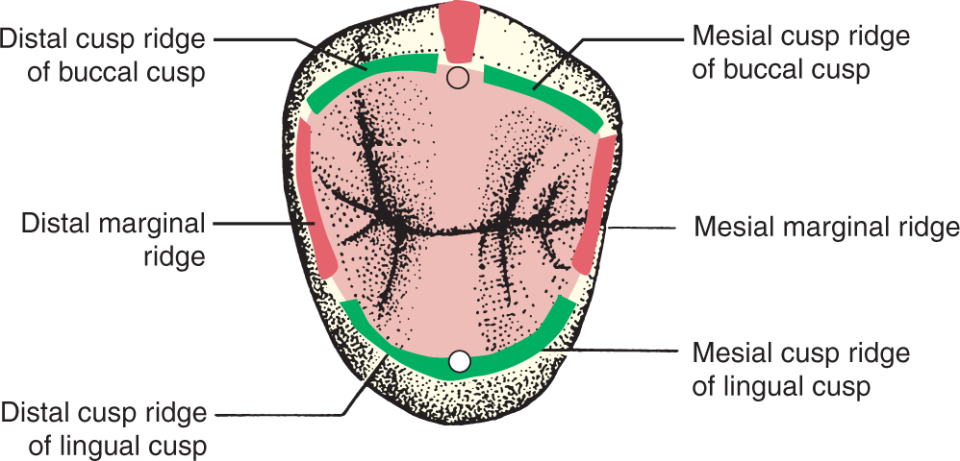12 - morphology of the lower premolars
1/7
There's no tags or description
Looks like no tags are added yet.
Name | Mastery | Learn | Test | Matching | Spaced |
|---|
No study sessions yet.
8 Terms
whats in the essay?
function + general
buccal morphology
lingual
proximal view
occlusal morphology
shape of 3 cusp and 2 cusp type
function + general
inital mastication
canine assistance in chewing
vertical dimension maintenance (between nose and chin)
1st mand premolar has 2 cusps and 1 root, 2nd mand premolar has 3 cusps and 1 root
buccal morphology (+ roots)
mand 1st premolars = slightly longer than 2nd (longer crown but shorter root)
mand 1st premolar has sharper buccal cusp (110. degrees) bc of steeper angle of cusp ridges of buccal cusp
contact areas are more cervical on cusp tip in mand 1st premolars than 2nd
mesial contact areas are near junction of middle and occlusal thirds
distal contact area is an EXCEPTION → more occlusal than the mesial contact (its usually more cervical) bc dist marg ridge = more horizonal
crown shape = pentagon
mand 1st = 1 B cusp, 1 L cusp
mand 2nd pm = 1 b, 2 lingual
roots:
each tooth has one root
roots tend to taper apically
apical third bends distally
mandibular 1st roots are thinner and slightly shorter than mand 2nd premolar roots

lingual morphology
mand 1st premolar is narrower mesiodistally on the lingual side
SOMETIMES if 2nd mand premolar has only one lingual cusp (aka only 2 cusps, its narrower lingually)
ONLY 3 cusp mand 2nd premolars have wider crowns lingually
mand 1st prem lingual cusp is pointed on the tip and shorter
mand 2nd molars with ONE lingual cusp - the lingual cusp is smaller than the buccal cusp but still longer than the lingual cusp of the 1st premolar
single lingual cusp tip is more mesial to the centre line of the root. in the 2 lingual cusp variation, there is one large buccal and 2 lingual cusps
GROOVES:
MAND 1ST mesiolingual groove separates the mesial slope of the lingual cusp from the mesial marginal ridge (adloff notch)
on MAND 2ND: LINGUAL groove between mesiolingual and distolingual cusps
proximal view; + root depression mention
mand molars shaped like rhomboid from proximal view (upper = trap, lower = rhomb)
distal marginal ridge of mand 1st is more horizontal which is what makes it (uniquely) more occuslal than the mesial marge groove
in 2nd mand, mesial marge groove = more occlusal like normal
mesiolingual groove is not present on 2nd mand, only first
more prominent root depression on distal surface of root in ALL premolars apart from max 1st molar
occlusal morphology
not symmetirical = more bulk in distal half
Tooth
Cusp Number
Shape from occlusal view
Mandibular 1st premolar
2
Diamond-shaped (mesiolingual pushed in)
Mandibular 2nd premolar
2
Rounded / oval
Mandibular 2nd premolar
3
Square or rectangular (wider)
3 cusp type - what shape?
Y shape bc of developmental gtooves
occlusla surface contains:
central pit
mesial developmental groove
mesial triangular fossa
distal developmental groove
distal triangular fossa
lingual developmental groove
supplemental grooves
2 cusp type
- one buccal cusp and one well developed lingual cusp is present
- a central groove travels in a mesiodistal direction and end in mesial and
distal fossa (forming ‘H’ shape)